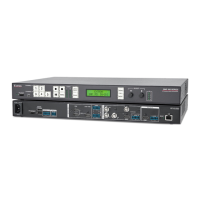About the link local IP address
The Networking pane displays a "Link Local" IP address. This address cannot be
changed by users. It is negotiated automatically by the SMP351. This address provides a
way for the unit to communicate on the network in a peer-to-peer fashion in the event that a
DHCP server is unavailable.
Regular, private IP addresses are assigned by a local network administrator either on a static
basis or automatically (using a DHCP server that has been set up with an assigned range of
addresses). This is one form of a client-server system.
Many routers come from the manufacturer configured with a commonly-used range of
private addresses (for IPv4, the address range is 169.254.0.0 to 169.254.0.16) that
can be assigned using DHCP. In systems without a network administrator, the router can
assign numbers from that default range of addresses to devices on the LAN. This is another
way to set up a client-server system.
If a network has neither of the previous two options, individual devices (PCs, codecs,
decoders) generate and use their own link local addresses (for IPv4, the address range is
169.254.0.0 to 169.254.0.16). This method requires no network configuration of the
device, and it works using peer-to-peer communication rather than a client-server system.
Link local IP addresses use a separate range of addresses from those assigned by a DHCP
server so they cannot conflict with the server-assigned addresses.
Signals from devices using link local IP addresses are not routed by routers and gateways.
They stay within the local network. That makes it possible for many different LANs to use
the same range of link local IP addresses without creating conflicts.
Each LAN must use Network Address Translation (NAT) to hide private addresses and
present only one or few public addresses to other or larger networks.
5. If it will be used, configure Simple Network Management Protocol (SNMP). SNMP
facilitates the exchange of basic network management information between network
devices. It helps in monitoring of operations and factors such as bandwidth, memory
usage, remote password resets, and collection of error information. The text that is
specified in the SNMP-related fields is seen by the network community when the unit is
queried.
a. Select the Enable SNMP check box. When checked, the unit allows SNMP
communication. If unchecked (clear), the unit does not use SNMP.
b. If desired, type a new port number into the SNMP port: field or use the Up and
Down arrows to change the value.
c. To set a password for network management that will be publicly accessible,
enter a password in the Public Password: field. The password can be any
alphanumeric name of 4 to 12 characters. Letters, numbers, and hyphens are
allowed. Spaces, slashes, and symbols are not permitted.
NOTE: The public password is also referred to as the Public Community
String.
d. If desired, in the SNMP Contact: field, enter the name of the person who can
be contacted for assistance with this SMP351 unit in case someone (such as a
network administrator) has questions about this specific device.
e. The SNMP location description cannot be changed from within this panel. To
change the location description, click the Save button within this panel to save
the network settings, navigate to the Configuration > System Settings >
Unit Identification pane, enter a new location description in the Location
field, and click Save. Once the Web pages are refreshed or reloaded, the revised
location name appears in the SNMP section of the Networking pane.
6. Click Save.
SMP351 • Web-Based User Interface 116

